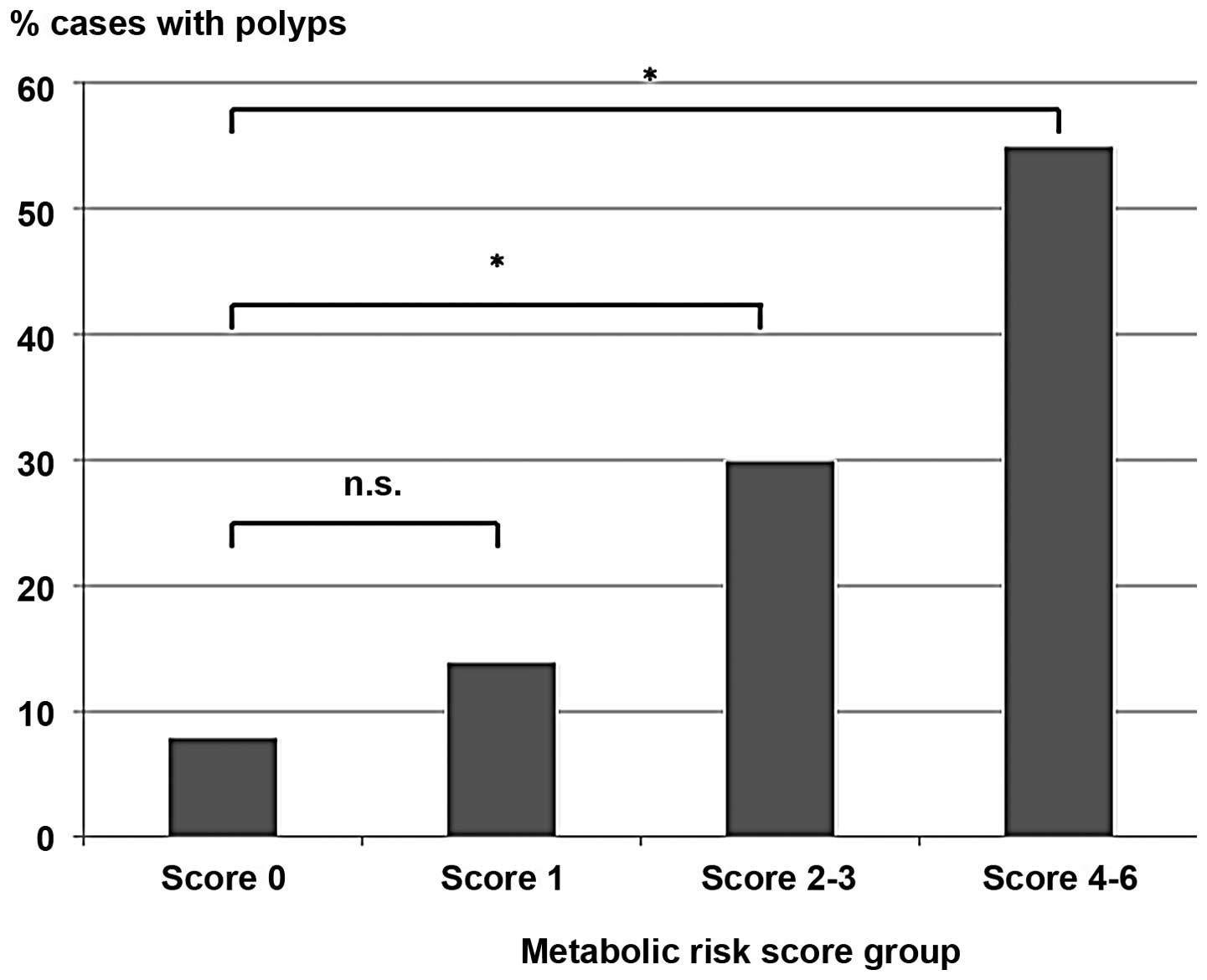Predicting the occurrence of cancer‑associated colorectal polyp using a metabolic risk score
- Authors:
- Nuengruetai Orannapalai
- Worapat Attawettayanon
- Samornmas Kanngern
- Teeranut Boonpipattanapong
- Surasak Sangkhathat
View Affiliations
Affiliations: Department of Surgery, Faculty of Medicine, Prince of Songkla University, Hat Yai, Songkhla 90110, Thailand, Anatomical Pathology Unit, Department of Pathology, Faculty of Medicine, Prince of Songkla University, Hat Yai, Songkhla 90110, Thailand
- Published online on: October 21, 2013 https://doi.org/10.3892/mco.2013.204
-
Pages:
124-128
Metrics: Total
Views: 0 (Spandidos Publications: | PMC Statistics: )
Metrics: Total PDF Downloads: 0 (Spandidos Publications: | PMC Statistics: )
This article is mentioned in:
Abstract
This study was conducted with the aim of developing a metabolic risk score to help identify patients who are likely to have a cancer‑associated polyp (CAP) on colonoscopy, based on a metabolic syndrome‑related clinical profile. The clinical history and anthropometric and metabolic profiles of patients who came for a screening colonoscopy at our institute between June, 2010 and December, 2012 were prospectively collected. The data were analyzed for their association with the occurrence of CAP. Subsequently, six parameters were selected in order to construct a metabolic risk score that correlated with the presence of CAP. A total of 286 subjects (132 males and 154 females), with an age range of 19‑85 years, were included in this study. The colonoscopy detected polyps in 56 cases (19.6%). Anthropometric parameters that were significantly associated with CAP included a body mass index (BMI) of >23.4 kg/m2 and a waist circumference of >32 inches in females. Laboratory profiles that were significantly associated with CAP were fasting blood sugar (FBS) >110 mg%, hemoglobin A1C (HbA1C) >7%, aspartate transaminase (SGOT) >40 IU̸l, alanine transaminase (SGPT) >50 IU̸l and uric acid >7 mg%. When a metabolic risk score was constructed, it was observed that moderate (2‑3) and high risk (4‑6) was significantly associated with CAP [odds ratio (OR)=4.9, 95% confidence interval (CI): 2.0‑12.0 and OR=13.7, 95% CI: 4.4‑43.0, respectively]. The association between the risk score and CAP was stronger in the subgroup of patients aged <65 years, in whom the moderate and high metabolic risk groups exhibited ORs of 5.6 (95% CI: 1.8‑17.9) and 39.0 (95% CI: 8.2‑186.6), respectively. In conclusion, this study demonstrated that it is possible to use a metabolic profile to construct a reliable scoring method to identify patients at higher risk of having CAP who should be fast‑tracked for a colonoscopy.
View References
|
1.
|
Zimmet P, Magliano D, Matsuzawa Y, Alberti
G and Shaw J: The metabolic syndrome: a global public health
problem and a new definition. J Atheroscler Thromb. 12:295–300.
2005. View Article : Google Scholar : PubMed/NCBI
|
|
2.
|
Chen M, He M, Min X, et al: Different
physical activity subtypes and risk of metabolic syndrome in
middle-aged and older Chinese people. PLoS One. 8:e532582013.
View Article : Google Scholar : PubMed/NCBI
|
|
3.
|
Eckel RH, Grundy SM and Zimmet PZ: The
metabolic syndrome. Lancet. 365:1415–1428. 2005. View Article : Google Scholar : PubMed/NCBI
|
|
4.
|
Esposito K, Chiodini P, Colao A, Lenzi A
and Giugliano D: Metabolic syndrome and risk of cancer: a
systematic review and meta-analysis. Diabetes Care. 35:2402–2411.
2012. View Article : Google Scholar : PubMed/NCBI
|
|
5.
|
Aleksandrova K, Nimptsch K and Pischon T:
Influence of obesity and related metabolic alterations on
colorectal cancer risk. Curr Nutr Rep. 2:1–9. 2013. View Article : Google Scholar : PubMed/NCBI
|
|
6.
|
Pais R, Silaghi H, Silaghi AC, Rusu ML and
Dumitrascu DL: Metabolic syndrome and risk of subsequent colorectal
cancer. World J Gastroenterol. 15:5141–5148. 2009. View Article : Google Scholar : PubMed/NCBI
|
|
7.
|
Guffey CR, Fan D, Singh UP and Murphy EA:
Linking obesity to colorectal cancer: recent insights into
plausible biological mechanisms. Curr Opin Clin Nutr Metab Care.
16:595–600. 2013. View Article : Google Scholar : PubMed/NCBI
|
|
8.
|
Wang YY, Lin SY, Lai WA, Liu PH and Sheu
WH: Association between adenomas of rectosigmoid colon and
metabolic syndrome features in a Chinese population. J
Gastroenterol Hepatol. 20:1410–1415. 2005. View Article : Google Scholar
|
|
9.
|
Liao KF, Lai HC, Lai SW, Cheng KC and Lin
CH: Association between rectosigmoid adenomas and cardiovascular
risk factors: a hospital-based, cross-sectional study. Ann Acad Med
Singapore. 38:630–636. 2009.PubMed/NCBI
|
|
10.
|
Winawer SJ, Zauber AG, Ho MN, et al:
Prevention of colorectal cancer by colonoscopic polypectomy. The
National Polyp Study Workgroup N Engl J Med. 329:1977–1981. 1993.
View Article : Google Scholar : PubMed/NCBI
|
|
11.
|
Walsh JM and Terdiman JP: Colorectal
cancer screening: scientific review. JAMA. 289:1288–1296. 2003.
View Article : Google Scholar : PubMed/NCBI
|
|
12.
|
Yang MH, Rampal S, Sung J, et al: The
association of serum lipids with colorectal adenomas. Am J
Gastroenterol. 108:833–841. 2013. View Article : Google Scholar : PubMed/NCBI
|
|
13.
|
Ulaganathan V, Kandiah M, Zalilah MS, et
al: Colorectal cancer and its association with the metabolic
syndrome: a Malaysian multi-centric case-control study. Asian Pac J
Cancer Prev. 13:3873–3877. 2012. View Article : Google Scholar : PubMed/NCBI
|
|
14.
|
Kim BC, Shin A, Hong CW, et al:
Association of colorectal adenoma with components of metabolic
syndrome. Cancer Causes Control. 23:727–735. 2012. View Article : Google Scholar : PubMed/NCBI
|
|
15.
|
Rex DK, Petrini JL, Baron TH, et al:
Quality indicators for colonoscopy. Am J Gastroenterol.
101:873–885. 2006.PubMed/NCBI
|










